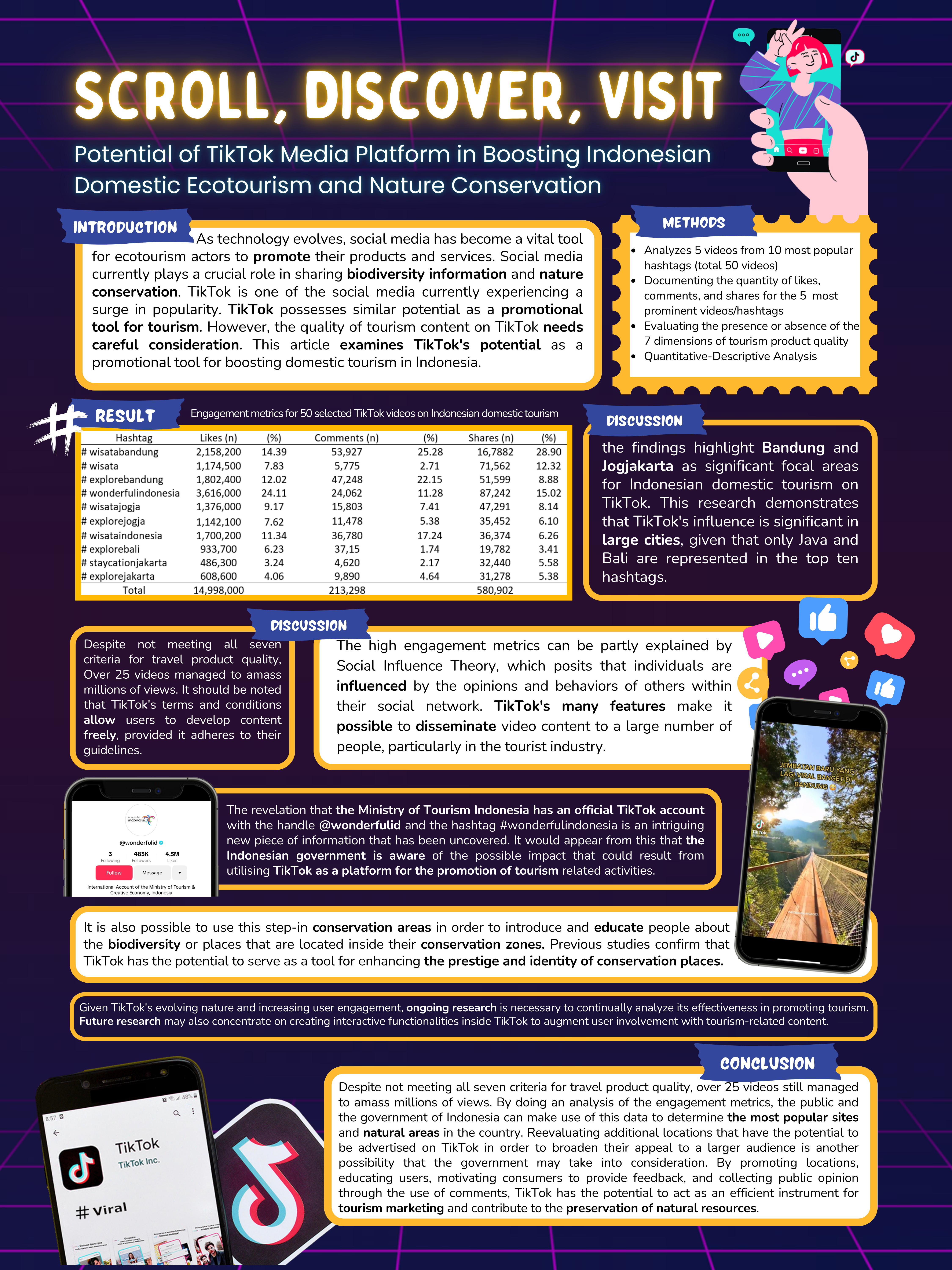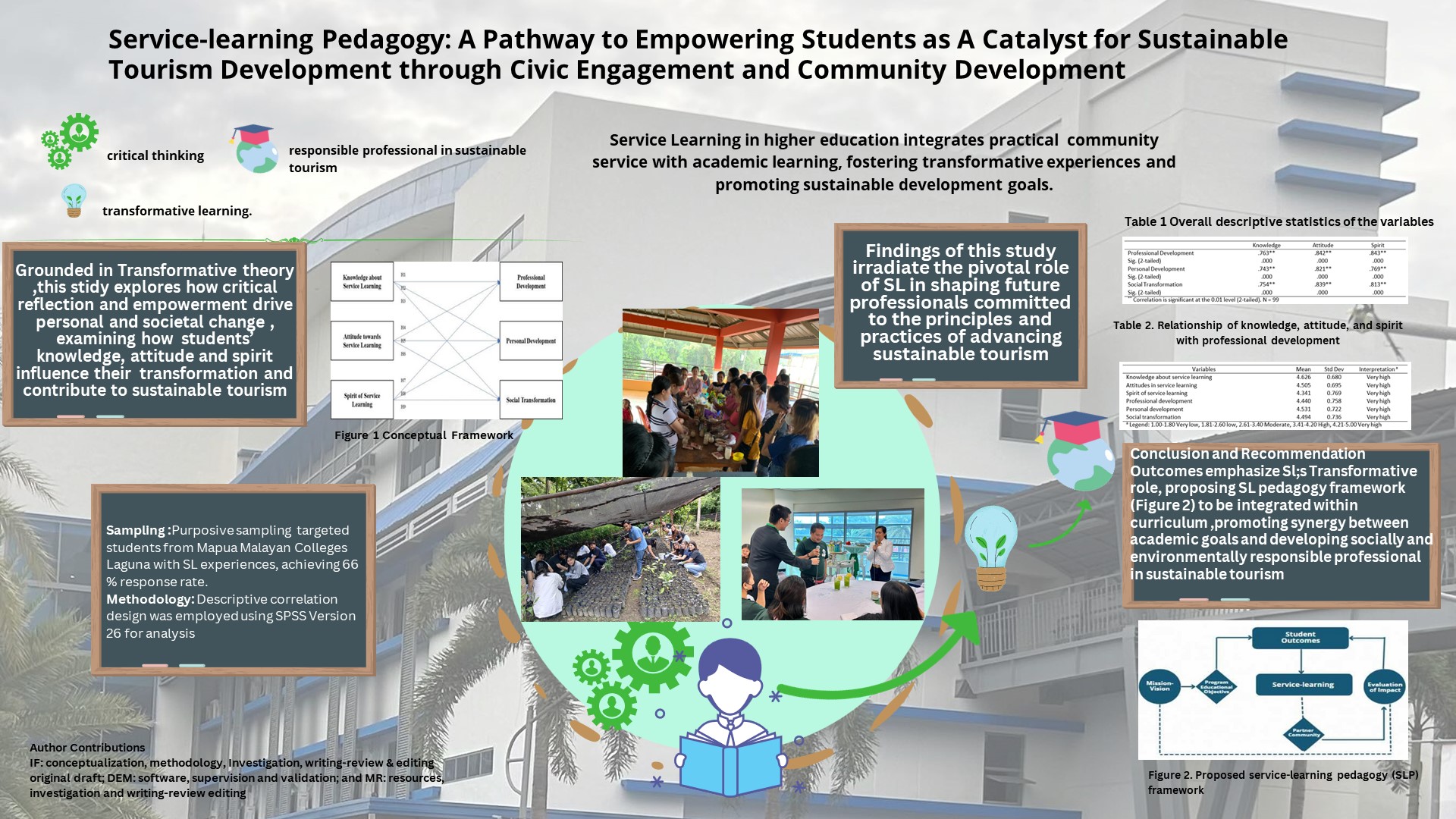Will Virtual Reality Experience Quality be an Alternative to Offline Visit Decision? Review of Literature on Tourist Behaviour on Instagram Social Media
Abstract
Virtual reality is the latest addition to the tourism industry, leveraging advancements in Internet technology. The advent of Virtual Reality (VR) tourism technology offers a comprehensive portrayal of tourist destination details and mitigates customer apprehension or uncertainty by acquainting consumers with unfamiliar locales. Virtual reality is a highly captivating advancement in tourism marketing that enables consumers to immerse themselves in and encounter destinations in real-time. The objective of this study is that explains how virtual reality can be used to replace traditional offline decision-making processes in the tourism industry. This study employs a comprehensive review of existing literature on the utilisation of virtual reality and its influence on offline visitation choices. Subsequently, a conceptual framework and research hypotheses are formulated. This research paper explores the behaviour of tourists who engage in offline or virtual experiences. Multiple articles were assessed for future research advancements. The findings of this study reveal distinct patterns of tourist behaviour, particularly among millennials, in relation to their ability to adapt to technological advancements. The research findings are anticipated to offer both theoretical and practical benefits to stakeholders involved in tourism technology, particularly in its application as a marketing instrument.
References
2. Chen, H. S. Int J Environ Res Public Health, 2020, 17, 1–20.
3. Tseng, C. H.; Wei, L. F. The Efficiency of Mobile Media Richness Across Different Stages of Online Consumer Behavior. Int J Inf Manage, 2020, 50, 353–64.
4. Grewal, D.; Roggeveen, A. L.; Nordfält, J. The Future of Retailing. J Retail, 2017, 93, 1–6.
5. Flavián C, Ibáñez-Sánchez S, and Orús C 2019 The Impact of Virtual, Augmented and Mixed Reality Technologies on The Customer Experience. J Travel Tour Mark, 2019, 36, 847–63.
6. Beck, J.; Rainoldi, M.; Egger, R. Virtual Reality in Tourism: A State-Of-The-Art Review. Tour Rev, 2019, 74, 586–612.
7. Satyarini, N. W. M.; Rahmanita, M.; Setarnawat, S. Community Empowerment in Plempoh Cultural Tourism Village. TRJ Tour Res J, 2017, 1, 81.
8. Sánchez, M. R.; Palos-Sánchez, P. R.; Velicia-Martin, F. Eco-friendly Performance as A Determining Factor of The Adoption of Virtual Reality Applications in National Parks. Sci Total Environ, 2021, 798.
9. Pujiastuti, E. E.; Nimran, U.; Suharyono; Kusumawati, A. The Antecedents of Behavioral Intention Regarding Rural Tourism Destination. Russ J Agric Socio-Economic Sci, 2017, 61, 148–59.
10. Li, T.; Chen, Y. Will virtual reality be a double-edged sword? Exploring the Moderation Effects oThe Expected Enjoyment of A Destination on Travel Intention. J Destin Mark Manag, 2019, 12, 15–26.
11. An, S.; Choi, Y.; Lee, C. K. Virtual Travel Experience and Destination Marketing: Effects of Sense and Information Quality on Flow and Visit Intention. J Destin Mark Manag, 2021, 19.
12. Lee, W. J.; Kim, Y. H. Does VR Tourism Enhance Users' Experience?. Sustainanility, 2021, 13(2), 806.
13. Lee, U. K. Tourism Using Virtual Reality: Media Richness and Information System Successes. Sustain, 2020, 14, 3975.
14. Geng, L.; Li, Y.; Xue, Y. Will the Interest Triggered by Virtual Reality (VR) Turn into Intention to Travel (VR vs. Corporeal)? The Moderating Effects of Customer Segmentation. Sustain, 2022, 14, 12.
15. Trabelsi-Zoghlami, A.; Touzani, M. How Real Are Virtual Experiences?. Eur J Mark, 2019, 53, 12–36.
16. Zeng, G.; Cao, X.; Lin, Z.; Xiao, S. H. When Online Reviews Meet Virtual Reality: Effects on Consumer Hotel Booking. Ann Tour Res, 2020, 81.
17. Lo, W. H.; Cheng, K. L. B. Does Virtual Reality Attract Visitors?. Inf Technol Tour, 2020, 22, 537–562.
18. Tjiptono, F.; Andrianombonana, H. T. R. J Mark Logist, 2016, 28, 78–97.
19. Kotler, P.; Gertner, D. Country as Brand, Product, and Beyond: A Place Marketing and Brand Management Perspective. J Brand Manag, 2022, 9, 249–261.
20. Dora, A.; Patrícia, O.; Valle, D.; J da, C. M. The Cognitive-Affective-Conative Model of Destination Image: A Confirmatory Analysis. J Travel Tour Mark, 2013, 30, 471-481.
21. Chandralal, L.; Valenzuela, F. R. Contemporary Management Research. Memorable Tourism Experiences: Scale Development Contemp Manag Res, 2015, 11, 291–310.
22. Abodeeb, J.; Wilson, E,; Moyle, B. Shaping Destination Image and Identity: Insights for Arab Tourism at the Gold Coast, Australia. Int J Cult Tour Hosp Res, 2015, 1, 6–21.
23. Vinyals-Mirabent, S. European Urban Destinations’ Attractors at The Frontier Between Competitiveness and A Unique Destination Image. A Benchmark Study of Communication Practices. J Destin Mark Manag, 2019, 12, 37–45.
24. Albaity, M.; Melhem, S. B. Novelty Seeking, Image, and Loyalty—The Mediating Role of Satisfaction and Moderating Role of Length of Stay: International Tourists' Perspective, Tour Manag Perspect, 2017, 23, 30–37.
25. Fuchs, G.; Uriely, N.; Reichel, A.; maoz D. Vacationing in a Terror-Stricken Destination Tourists’ Risk Perceptions and Rationalizations. J Travel Res, 2013, 52, 182–191.
26. Meng, B.; Han, H. Effect of Environmental Perceptions on Bicycle Travelers’ Decision-Making Process: Developing an Extended Model of Goal-Directed Behavior. J Travel Tour Mark, 2018, 35, 973–987.
27. Moore, K.; Smallman, C.; Wilson, J.; Simmons, D. Dynamic In-Destination Decision-Making: An Adjustment Model. Tour Manag, 2012, 33, 635–645.
28. Doosti, S.; Jalilvand, M. R.; Asadi, A.; Khazaei, Pool, J.; Mehrani, Adl. P. Analyzing The Influence of Electronic Word of Mouth on Visit Intention: The Mediating Role of Tourists’ Attitude and City Image. Int J Tour Cities, 2016, 2, 137–148.
29. Luo, J. M. Lam, C. F. The Development of Measurement Scale for Entertainment Tourism Experience: A Case Study in Macau. Entertainment Tourism, Macau, Taylor and Francis, 2017, 1–65.
30. Willems, K.; Brengman, M.; Kerrebroeck, V. H. The Impact of Representation Media on Customer Engagement in Tourism Marketing among Millennial. Eur J Mark, 2019, 53, 1988–2017.
31. Pop, R. A.; Săplăcan, Z.; Dabija, D. C.; Alt, M. A. The Impact of Social Media Influencers on Travel Decisions: The Role of Trust in Consumer Decision Journey. Curr Issues Tour, 2022, 25, 823–843.
32. Chang, H. H. J Vacat Mark. 28, 211–227.
33. Mehrabian, A.; Russell, J. A. An Approach to Environmental Psychology. Boston, MIT, 1974.
34. Leung, W. K. S.; Cheung,M. L.; Chang, M. K.; Shi, S.; Tse, S. Y.; Yusrini. The Role of Virtual Reality Interactivity in Building Tourists’ Memorable Experiences and Post-Adoption Intentions in The COVID-19 Era. J Hosp Tour Technol, 2022, 13, 481–499.
35. Rajaguru, R. Motion Picture-Induced Visual, Vocal and Celebrity Effects on Tourism Motivation: Stimulus Organism Response Model. Asia Pacific J Tour Res, 2014, 19, 375–388.
36. Bong, K. S.; Jin, B. Predictors of Purchase Intention Toward Green Apparel Products: A Cross-Cultural Investigation in The USA And China. J Fash Mark Manag, 2017, 21, 70–87.
37. Lee, S. A.; Lee, M.; Jeong, M. The Role of Virtual Reality on Information Sharing and Seeking Behaviors. J Hosp Tour Manag, 2021, 46, 215–223.
38. Skinner, B. F. The behavior of organisms An Expriemental Analysis Psychological Record. New York, Appleton Century Crofts, Inc, 1938, 1-486.
39. Crompton, J. L. An Assessment of the Image of Mexico as a Vacation Destination and the Influence of Geographical Location upon the Image. J Travel Res, 1979, 17, 18–23.
40. Lee, T. H.; Crompton, J. Measuring Novelty Seeking in Tourism. Ann Tour Res, 1992, 19, 732–751.
41. Bigne, E.; Maturana, P. Does Virtual Reality Trigger Visits and Booking Holiday Travel Packages?. Cornell Hosp Q, 2022, 64, 226-245.
42. Baltas, G.; Kokkinaki, F. Does Variety Seeking Vary Between Hedonic and Utilitarian Products? The Role of Attribute Type. J Cons Behaviour, 2017, 13, 1–12.
43. De Canio, F.; Martinelli, E.; Peruzzini, M.; Marchi, G. Experiencing a Food Production Site Using Wearable Devices: The Indirect Impact of Immersion and Presence in VR Tours. Ital J Mark, 2021,3, 209–226.
44. Stewart Jr, W. H.; May, R. C.; Ledgerwood, D. E. Do You Know What I know? Intent to Share Knowledge in the US and Ukraine. Manag Int Rev, 2015, 55, 737–773.
45. Venkatesh, V.; Thong, J. Y.; Xu, X. Unified Theory of Acceptance and Use of Technology: A Synthesis and the Road Ahead. Behav Mark eJournal, 2012, 36, 157–178.
46. Kunz, R. E.; Santomier, J. P. Sport Content and Virtual Reality Technology Acceptance. Sport Bus Manag An Int J., 2019, 10, 83–103.
Authors

This work is licensed under a Creative Commons Attribution 4.0 International License.
Authors submitting manuscripts should understand and agree that, upon publication, the manuscripts will be licensed under a Creative Commons Attribution (CC BY) license. This means that others are free to share, adapt, and build upon the work for any purpose, even commercially, as long as they give appropriate credit to the authors for the original creation.






